Last Updated on November 25, 2023 by Kittredge Cherry
Pioneering LGBTQ rights activist Harvey Milk is the first and most famous openly gay male elected official in California. His birthday (May 22) is a state holiday. He has been called a martyr for LGBTQ rights — and for all human rights. “If a bullet should enter my brain, let that bullet destroy every closet door in the country,” Milk said. Two bullets did enter his brain, and his vision of LGBTQ people living openly is also coming true.
He broke stereotypes about gay men and broke barriers for LGBTQ people. Milk became the public face of the LGBTQ liberation movement, and his reputation has continued to grow since his death. He was assassinated on Nov. 27, 1978.
As America’s first openly gay man elected to public office in a major city, Milk was responsible for passing a tough gay-rights law in San Francisco before he was killed. (When Milk was elected in 1977, other gay/lesbian politicians who preceded him included lesbian Massachusetts State Representative Elaine Noble; Minnesota State Senator Allan Spear, who came out in 1974 after he won re-election; and Kathy Kozachenko who was elected in 1974 to the City Council in Ann Arbor, Michigan.)
Some California cities fly the rainbow flag over their City Halls from Harvey Milk Day on May 22 through the end of June for Pride Month. Huntington Beach was one of them until 2023 , when it voted to ban the practice as “divisive.”
Milk is remembered in many books, shirts, posters and artworks, often with his famous quote, “Hope will never be silent.” More than 40 years later, the hope and the movement for LGBTQ rights are more alive than ever.
A “born politician” who found his calling at age 40
Milk was born May 22, 1930 in the suburbs of New York City to Jewish Lithuanian parents. He shares a birthday with another LGBTQ pioneer, black gay Harvard minister Peter Gomes. Although Milk was called a “born politician” by journalist Frances Fitzgerald, Milk was not openly gay or active in politics until age 40. His sense of humor made him popular throughout his life. In school he played sports and wrote newspaper columns. He adored opera. Like many gay men of his era, he lived a double life, hiding his sexual orientation with family and at work. He joined the Navy and was forced to accept an “other than honorable” discharge for his homosexuality. A man of many interests, he changed relationships and jobs frequently, working on both Broadway and Wall Street. He was a associate Broadway producer, Wall Street financial analyst, public-school teacher and insurance actuary. He campaigned as a volunteer for Republican Barry Goldwater in the 1964 U.S. presidential election, but the Vietnam War led to a change of heart, and he joined in anti-war protests.
Milk and his lover Scott Smith were running a camera shop on San Francisco’s gay-oriented Castro Street when Milk found his vocation and entered politics in 1973.
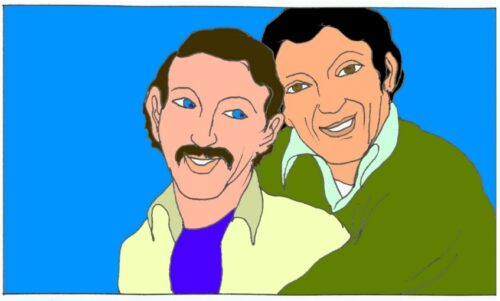
Harvey Milk and Scott Smith embrace in a picture from “Heavenly Homos, Etc.: Queer Icons from LGBTQ Life, Religion, and History” by Jan Haen, a Dutch artist and priest. He includes scenes from Milk’s life that are rarely if ever portrayed by artists.
He served only 11 months on the San Francisco Board of Supervisors before his death, but in that short time he fought for the rights of the elderly, small business owners, and the many ethnic communities in his district as well as for the growing LGBTQ community.
As a politician, he was known for his eloquence and for building coalitions among diverse groups, including women, Asians, Latinx, the disabled, and labor unions. His supporters included lesbians as well as gay men, although the role of lesbians has often been downplayed. He and lesbian feminist activist, speech professor and theologian Sally Gearhart co-chaired the main organization that defeated California Proposition 6, known as the Briggs Initiative, which would have banned lesbian and gay teachers. They were friends and debate partners who together famously debated conservative politician John Briggs on TV. Milk hired lesbian activist Anne Kronenberg as campaign manager for his historic 1977 election, and she continued as his aide until his death.
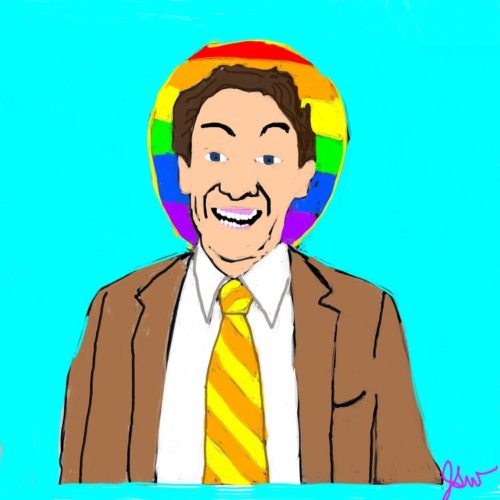
“Harvey Milk” by Jeremy Whitner. Prints are available at Whitner’s Fine Art America shop.
Milk has a halo with the rainbow colors of the LGBTQ community in a 2022 portrait by North Carolina artist Jeremy Whitner. It appears at the top of this post. Whitner is a queer Christian iconographer in process for ministry with the Disciples of Christ. He attends Union Presbyterian Seminary in Charlotte, North Carolina.
Milk remains controversial. This profile was attacked in the 2018 article “Catholic LGBT Ministry Canonizes Serial Pederast” on the website ChurchMilitant.com, run by Michael Voris, one of the Catholic Church’s most vocal opponents of LGBTQ causes. Discussion on Kittredge Cherry’s Facebook page has more than 60 supportive comments.
Harvey Milk Day celebrates equality on May 22
 |
| Harvey Milk Day March, by Show Me No Hate St. Louis, MO |
Harvey Milk Day events happen all across America, especially in California, where it became an official state holiday in 2009 and public schools are encouraged to teach suitable commemorative lessons about the LGBTQ rights activist. Milk is the only openly gay person in the United States to receive such a distinction.
Resources tend to emphasize that Milk was more than an LGBTQ rights activist, but also a “social and political pioneer” who ”fought for the rights and equality of all” and inspires “disenfranchised communities.”
 Harvey Milk Day events often include showing one of the two Oscar-winning movies about his life, the documentary “The Times of Harvey Milk
Harvey Milk Day events often include showing one of the two Oscar-winning movies about his life, the documentary “The Times of Harvey Milk” (1984) or the biographical drama “Milk
” (2008), which stars Sean Penn as Milk in an performance that won an Academy Award for best actor. The movie tells how he rose to become one of America’s first openly gay elected leaders, only to be killed by an assassin’s bullet. Directed by Gus Van Sant, the film got eight Academy Award nominations.
Harvey Milk assassinated on Nov. 27, 1978
An assassin shot Harvey Milk and San Francisco mayor George Moscone on Nov. 27, 1978. Haunted by the sense that he would be killed for political reasons, Milk had recorded tapes to be played in the event of his assassination. His message, recorded nine days before his death, included this powerful statement:
“I ask for the movement to continue, for the movement to grow, because last week I got a phone call from Altoona, Pennsylvania, and my election gave somebody else, one more person, hope. And after all, that’s what this is all about. It’s not about personal gain, not about ego, not about power — it’s about giving those young people out there in the Altoona, Pennsylvanias, hope. You gotta give them hope.”
The shots were fired by conservative fellow supervisor Dan White, an ex-policeman and former firefighter. At his trial, he used the so-called “Twinkie defense” by claiming that he had diminished capacity due to overeating sugary junk food. The jury found him guilty of voluntary manslaughter instead of first-degree murder. Outrage over his seven-year sentence sparked the White Night riots of May 21, 1978. Less than two years after he was released from prison, White committed suicide on Oct. 21, 1985.
Milk is considered an Advent saint by some Christians because the timing of his death coincides with the start of the liturgical season of Advent, a time to prepare for God’s arrival in the world.
Harvey Milk honored
Milk has received much recognition for his visionary courage and commitment to equality. In 2014 the U.S. Postal Service issued a stamp in his honor, with the rainbow colors of the LGBTQ pride flag appear as a vertical strip in the top left corner. Other LGBTQ people have appeared on U.S. stamps, but this is the first to feature someone specifically for LGBTQ activism.
In 2009 he was posthumously awarded the Presidential Medal of Freedom and inducted into the California Hall of Fame. He was included in the Time “100 Heroes and Icons of the 20th Century” for being “a symbol of what gays can accomplish and the dangers they face in doing so.”
Construction of a navy ship named after Milk began in 2019 — six decades after he was forced out of the Navy for being gay. He became the first openly gay person to have a Navy ship named after him. The U.S. military has a long anti-LGBTQ history with an estimated 100,000 service members discharged due to their sexual orientation, so it was a symbolic milestone when they christened a ship after the LGBTQ-rights icon.
Harvey Milk in religious and spiritual art: Robert Lentz
A 1980s icon of Milk by Robert Lentz is greatly beloved by many, but criticized by some for imposing Christian imagery onto a secular Jew. The interfaith problem is solved, or perhaps compounded, by Carl Grauer’s 2019 painting of Milk with attributes of a Hindu deity. Both paintings appear at the top of this post.
The Harvey Milk icon painted by Robert Lentz was hailed as a “national gay treasure” by gay author/activist Toby Johnson. Milk holds a candle and wears an armband with a pink triangle, the symbol that Nazis used to identify gay men. Here is expresses solidarity with all who were tortured or killed because of their sexuality. Milk actually wore such an armband in San Francisco’s 1978 Gay Freedom Day Parade. In Nazi Germany, Milk might have been forced to wear a yellow star of David that was used to identify Jews — or the badge for gay Jews that formed a star of David from a pink triangle and a yellow triangle. The candle is like those carried at the candlelight vigil of 40,000 people at San Francisco’s City Hall on the night that Milk was killed.
Prints of “Harvey Milk of San Francisco” by Robert Lentz are available through Amazon and Trinity Stores. It is one of 40 icons featured in the book “Christ in the Margins” by Robert Lentz and Edwina Gateley. Lentz discusses the icon in a YouTube video.
The Harvey Milk icon is one of 10 icons that sparked a church controversy in 2005. Critics accused Lentz of glorifying sin and creating propaganda for a progressive sociopolitical agenda, and he temporarily gave away the copyright for this and nine other controversial images to his distributor. All 10 were displayed there as a collection titled “Images That Challenge.”
The icon has also been criticized as antisemitic for portraying Milk, a secular Jew, in a iconographic style rooted in Christian tradition. Milk himself said, “The fact is that more people have been slaughtered in the name of religion than for any other single reason. That, that my friends, that is true perversion!”
The halo in the Harvey Milk icon can be seen as a sign of respect for a hero who promoted universal human values beyond any particular religion. As one admirer wrote in a Facebook debate on the issue, “For that liberating work, he can have as many halos as I can give him. Crown him with many crowns!”
Is it wrong to portray Milk with Christian symbols?
 One scholar who questions the use of Christian symbols to glorify Milk is Brett Krutzsch, visiting assistant professor of religion at Haverford College in Pennsylvania. A chapter on Milk is included in his 2019 book “Dying to be Normal: Gay Martyrs and the Quest for Equality,” which was published by Oxford University Press. The book examines how activists applied Christian traditions to prominent LGBTQ deaths to counteract Christian conservatives between 1995 and 2015.
One scholar who questions the use of Christian symbols to glorify Milk is Brett Krutzsch, visiting assistant professor of religion at Haverford College in Pennsylvania. A chapter on Milk is included in his 2019 book “Dying to be Normal: Gay Martyrs and the Quest for Equality,” which was published by Oxford University Press. The book examines how activists applied Christian traditions to prominent LGBTQ deaths to counteract Christian conservatives between 1995 and 2015.
The first chapter of “Dying to be Normal” opens with an insightful description of how and why Christian imagery was applied to Milk:
“In 2003 San Francisco’s GLBT History Museum, the first American museum dedicated to gay, lesbian, bisexual, and transgender history, opened its doors to unveil the museum’s inaugural exhibit; a massive cross made from the blood-soaked suit Harvey Milk wore when he was shot to death in 1978. Titled “Saint Harvey: The Life and Afterlife of a Modern Gay Martyr,” the exhibition provided a venue for people to learn about Harvey Milk’s life and legacy. With Milk’s bullet-punctured suit displayed as a cross, the GLBT History Museum depicted Milk’s assassination, like Christ’s crucifixion, as an event of transformative and salvific significance. Through the use of a central Christian symbol, the museum memorialized Milk not as a murdered city politician, but as a sacrificed savior for the American gay rights movement….”
Critics sometimes say that there are no saints in Jewish tradition. William Gilders, religion professor at Emory University, explores how Milk may fit into the Jewish tradition of saints that can be found outside mainstream American Ashkenazi Judaism. He considers how American LGBTQ Jews refrained from drawing on this tradition to discuss or represent Milk in his forthcoming book “Harvey Milk Lives! The Afterlives of a Gay Martyr.”
Harvey Milk in religious and spiritual art: Carl Grauer
Milk has six arms like a Hindu or Buddhist deity in a painting by Carl Grauer that appears at the top of this post. Hindu and Buddhist artists sometimes give divine figures with multiple arms as a way to represent their many super-powers. Each hand holds an item symbolizing a particular quality. One of those shown with up to a thousand arms is the androgynous bodhisattva of compassion known as Kuan Yin or Avalokiteshvara.
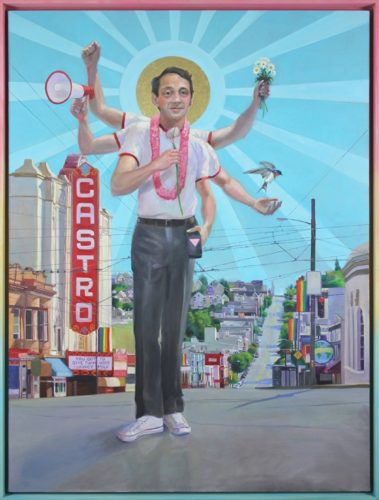
“Harvey Milk: You Have Got to Give Them Hope” from the series “The Lavender Temple of Their Most Fabulous” by Carl Grauer.
In Grauer’s vision, Milk raises a fist and a bullhorn, just as he did during fiery speeches for gay freedom. But he also holds a calla lily and a bouquet of daisies, evoking San Francisco’s gentle flower-power vibe. In another hand is a pink triangle, the sign imposed on gay men in Nazi concentration camps and later reclaimed as a symbol of gay pride. He stands on Castro Street, where he owned a camera shop in the heart of San Francisco’s gay neighborhood.
The painting is part of Grauer’s series “The Lavender Temple of Their Most Fabulous.” It debuted in June 2019 at the Carrie Haddad Gallery in Hudson, New York, for the 50th anniversary of the Stonewall Uprising. The artist revealed the holiness of the LGBTQ-rights struggle before and after Stonewall with portraits using religious imagery and handmade frames like Catholic altarpieces. He painted 15 LGBTQ pioneers, including Storme Delarverie, Marsha P. Johnson, Harvey Milk, Sylvia Rivera and Bayard Rustin.
The son of a former nun, Grauer grew up in rural Kansas in a conservative religious family that taught him homosexuality was a sin. His art reclaims religion for LGBTQ people. “I’m going to take those same structures that were used against (LGBTQ people) and say, ‘we are important.’ ” he said in an interview with High Country News.
Harvey Milk in other religious and spiritual art
Another artwork that puts Milk into a Christian context “Stations of the Cross: The Struggle For LGBT Equality” by Mary Button. Milk’s assassination is juxtaposed with Jesus falling under the weight of his cross in Station 9.
Harvey Milk is assassinated as Jesus falls in “Stations of the Cross: The Struggle For LGBT Equality” by Mary Button, courtesy of Believe Out Loud
Using bold colors and collage, Button puts Jesus’ suffering into a queer context by matching scenes from his journey to Golgotha with milestones from the last 100 years of LGBTQ history. For an overview of all 15 paintings in the series, see LGBT Stations of the Cross shows struggle for equality.

The Altar Cross of LGBTQ Martyrs from Metropolitan Community Church of San Francisco features photos of Matthew Shepard, Harvey Milk, Gwen Araujo and others.
A spiritual theme is also expressed in “Harvey’s Halo,” a San Francisco light installation that memorialized Milk by sending rainbow light into the foggy night sky. It was unveiled in 2017 for the 40th anniversary of Milk’s election. A video shows the lighting ceremony. It was choreographed to Queen’s hit song “We are the Champions,” which was released the same year that Milk was elected.
In conjunction with “Harvey’s Halo,” artist John Mavroudis created a portrait of Milk out of healing words and more than 150 names of people representing the LGBTQ community. He discusses it in a video.
Books about Harvey Milk
Books about Milk include:
 “Harvey Milk: His Lives and Death” by Lillian Faderman. A distinguished LGBTQ scholar does meticulous research and brings fresh insight into Milk’s life, including how he was influenced by the cultural values of his Jewish upbringing. Faderman has received many awards and three of her books were named Notable Books of the Year by the New York Times. Published by Yale University Press.
“Harvey Milk: His Lives and Death” by Lillian Faderman. A distinguished LGBTQ scholar does meticulous research and brings fresh insight into Milk’s life, including how he was influenced by the cultural values of his Jewish upbringing. Faderman has received many awards and three of her books were named Notable Books of the Year by the New York Times. Published by Yale University Press.
 “Pride: The Story of Harvey Milk and the Rainbow Flag” by Rob Sanders with illustration by Steven Salerno. This children’s picture book uses vibrant images and simple text to emphasize hope in the story of Harvey Milk. Recommended for kids in grades 1 to 3. The book opens with a quote from Milk, then tells his story along with the story of how Gilbert Baker designed the rainbow flag as a symbol of equality and pride stretching from 1970s marches to rainbow lights across the White House in 2015. Published by Random House Books for Young Readers.
“Pride: The Story of Harvey Milk and the Rainbow Flag” by Rob Sanders with illustration by Steven Salerno. This children’s picture book uses vibrant images and simple text to emphasize hope in the story of Harvey Milk. Recommended for kids in grades 1 to 3. The book opens with a quote from Milk, then tells his story along with the story of how Gilbert Baker designed the rainbow flag as a symbol of equality and pride stretching from 1970s marches to rainbow lights across the White House in 2015. Published by Random House Books for Young Readers.
 The classic biography of Milk is “The Mayor of Castro Street
The classic biography of Milk is “The Mayor of Castro Street” by Randy Shilts. The no-holds-barred tale of triumph, tragedy and political intrigue was written by one of the first openly gay reporters at a major newspaper. Published by St. Martin’s Press, it first came out in 1982.
Harvey Milk in music and theater
Milk’s assassination also inspired important musical creations. When lesbian singer-songwriter Holly Near learned of the assassination, she composed “Singing For Our Lives,” sometimes known as “Song for Harvey Milk.” It appears in the official Unitarian Universalist Association, with a title based on its first line: “We Are a Gentle, Angry People.” The song became an unofficial anthem of the LGBTQ rights movement and reached other justice movements, with new verses continuing to be added. It has been sung at countless marches and spiritual gatherings. Near introduces and sings it on a 2015 video of the 50th anniversary of the first national demonstration against the Vietnam War.
“Harvey Milk: An Opera in Three Acts” was composed by Stewart Wallace with a libretto by Michael Korie. A recording is available of a performance by the San Francisco Opera Chorus and Orchestra. Excerpts and related interviews are on video.
Playwright Patricia Loughrey was commissioned by Diversionary Theatre to write “Dear Harvey” for the 30th anniversary of his assassination. The documentary-style ensemble play recounts his life and lasting impact as the casts moves in and out of the identities of real-world figures whose lives he changed forever.
Harvey Milk Prayers
Milk’s life and legacy inspired “A Prayer for Harvey Milk Day” from All Saints Episcopal Church in Pasadena, California:
Almighty God, who created us in your own image: Grant us grace to follow the example of our brother Harvey Milk, that we might fearlessly contend against evil and to make no peace with oppression; and, that we may employ our freedom and our privilege in the maintenance of justice in our communities and among the nations. Ground us in your love and in your compassion to be agents of change and proclaimers of the hope that will never be silent. All this we ask in the name of the One who created us in love and called us to walk in love together. Amen.
Q Spirit honors Milk in its interfaith LGBTQ Saints series as a martyr who died in the struggle for LGBTQ rights.
Q Spirit’s Litany of Queer Saints includes these lines:
“Holy Harvey Milk, martyred gay rights pioneer and San Francisco politician, pray for us.”
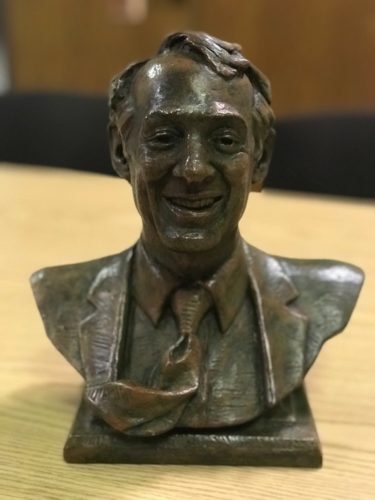
Harvey Milk commemorative sculpture by Daub Firmin Hendrickson Sculpture Group. This bust sits in the rotunda of San Francisco City Hall.
Milk appears with other progressive heroes in the one-minute video “Imagine a World Without Hate” made by the Anti-Defamation League. It imagines the headlines and accomplishments of Harvey Milk, Martin Luther King, Anne Frank, Matthew Shepard and others if their lives were not cut short by hate. More than a million people watched the video and some were so moved that they vowed to take action in their own lives against bigotry and bullying.
___
Links related to Harvey Milk:
The Illustrated Story of Harvey Milk, Humanitarian Martyr for Love (themarginalian.org)
Harvey Milk Day Quotes 2015: 11 Inspiring Sayings That Still Ring True Today (International Business Times)
SF City Hall Unveils Harvey Milk Tribute (advocate.com) (Bronze bust by Daub Firmin Hendrickson sculpture group)
List of first openly LGBT politicians in the United States (Wikipedia)
___
Top image credit:
“Harvey Milk of San Francisco” by Robert Lentz is part of Scott Sella’s sacred art collection in Akron, Ohio. Photo by Scott Sella. Prints of “Harvey Milk of San Francisco” by Robert Lentz are available through Amazon and Trinity Stores.
___
This post is part of the LGBTQ Saints series by Kittredge Cherry. Traditional and alternative saints, people in the Bible, LGBTQ martyrs, authors, theologians, religious leaders, artists, deities and other figures of special interest to lesbian, gay, bisexual and transgender and queer (LGBTQ) people and our allies are covered.
This article was originally published in May 2017, expanded with new material over time, and most recently updated on Nov. 25, 2023.
Copyright © Kittredge Cherry. All rights reserved.
Qspirit.net presents the Jesus in Love Blog on LGBTQ spirituality.

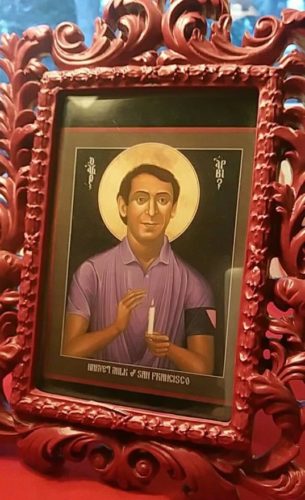


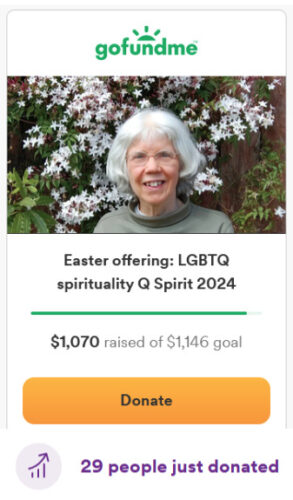






While Milk is today best known for his role as a gay-rights pioneer and one of the first openly LGBTQ people ever elected to public office in the U.S., Cleve Jones, an activist and a protege of Milk’s, said his mentor “was never a single-issue candidate.”